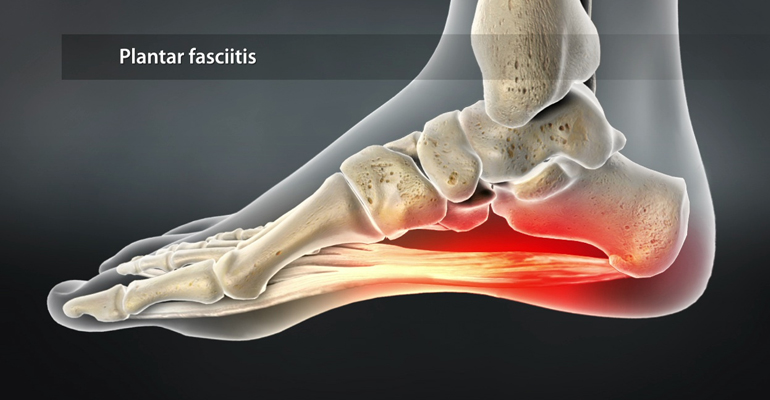-
-
+91-8591556577
-
Plantar Fasciitis

Plantar Fasciitis
Plantar Fasciitis is a common foot condition characterized by inflammation of the plantar fascia, a thick band of tissue that runs across the bottom of the foot, connecting the heel bone to the toes. This condition is a leading cause of heel pain, particularly among athletes and those who spend long hours on their feet. Understanding the causes, symptoms, and treatment options for plantar fasciitis can help individuals manage this condition effectively.
What Causes Plantar Fasciitis?
Plantar fasciitis typically results from excessive strain on the plantar fascia, which can lead to small tears and inflammation. Several factors contribute to the development of this condition:
- Overuse: Engaging in repetitive activities that place stress on the plantar fascia, such as running, dancing, or standing for extended periods, can lead to inflammation.
- Foot Structure: Abnormal foot mechanics, such as flat feet, high arches, or an abnormal walking pattern, can increase the strain on the plantar fascia.
- Obesity: Excess weight puts additional stress on the feet, increasing the risk of developing plantar fasciitis.
- Age: The risk of plantar fasciitis increases with age, as the plantar fascia can become less flexible and more prone to injury.
- Improper Footwear: Wearing shoes that lack proper arch support or cushioning can contribute to the development of plantar fasciitis.
Symptoms of Plantar Fasciitis
The primary symptom of plantar fasciitis is a sharp, stabbing pain in the heel, which is often most severe in the morning or after prolonged periods of sitting or standing. Other common symptoms include:
- Pain After Activity: Pain may worsen after physical activity or prolonged periods of standing or walking.
- Stiffness: The affected foot may feel stiff, particularly in the morning or after resting.
- Tenderness: There may be tenderness or soreness when pressing on the heel or arch of the foot.
- Pain with Flexing: Activities that require flexing the foot, such as climbing stairs or standing on tiptoes, may exacerbate the pain.
Diagnosing Plantar Fasciitis
A healthcare provider will typically diagnose plantar fasciitis based on a physical examination and a review of the patient's medical history. The examination may include assessing foot structure, flexibility, and walking patterns. Imaging tests, such as X-rays or MRI, are usually not necessary unless other conditions are suspected, such as fractures or arthritis.
Treatment Options for Plantar Fasciitis
The treatment approach for plantar fasciitis focuses on relieving pain and inflammation while promoting healing of the plantar fascia. Options may include:
Non-Surgical Treatments
- Rest and Activity Modification: Avoiding activities that worsen the pain is essential for recovery. Taking breaks and reducing high-impact activities can help alleviate symptoms.
- Ice Therapy: Applying ice to the affected area for 15-20 minutes several times a day can help reduce inflammation and relieve pain.
- Physical Therapy: A physical therapist can develop a customized exercise program to strengthen the muscles in the foot and lower leg, improve flexibility, and promote proper foot mechanics.
- Orthotic Devices: Custom orthotics or over-the-counter arch supports can provide added cushioning and support for the foot, helping to redistribute pressure away from the plantar fascia.
- Nonsteroidal Anti-Inflammatory Drugs (NSAIDs): Medications like ibuprofen or naproxen can help reduce pain and inflammation associated with plantar fasciitis.
- Stretching Exercises: Specific stretching exercises for the calf muscles and plantar fascia can help alleviate tension and improve flexibility.
- Night Splints: Wearing a splint at night can help keep the foot in a dorsiflexed position, gently stretching the plantar fascia and calf muscles overnight.
Surgical Treatments
In rare cases, when conservative treatments fail to provide relief after 6-12 months, surgical intervention may be considered. Surgical options for plantar fasciitis may include:
- Plantar Fascia Release: This procedure involves cutting a portion of the plantar fascia to relieve tension and alleviate pain.
- Fat Pad Augmentation: In this procedure, fat is harvested from another part of the body and injected into the heel to provide additional cushioning.
Recovery and Rehabilitation
Recovery from plantar fasciitis varies depending on the severity of the condition and the chosen treatment approach. Non-surgical treatments may take several weeks to months to show improvement, while surgical recovery can take longer. Engaging in a rehabilitation program that includes stretching and strengthening exercises is crucial for preventing future episodes of plantar fasciitis.
Preventing Plantar Fasciitis
To reduce the risk of developing plantar fasciitis, consider the following preventive measures:
- Wear Proper Footwear: Choose shoes with good arch support and cushioning to reduce strain on the plantar fascia.
- Maintain a Healthy Weight: Reducing excess weight can alleviate pressure on the feet and lower the risk of developing plantar fasciitis.
- Incorporate Stretching: Regularly stretching the calf muscles and plantar fascia can help maintain flexibility and reduce tension.
- Gradually Increase Activity Levels: When starting a new exercise program or increasing activity levels, do so gradually to avoid overloading the feet.
- Use Supportive Footwear for Activities: Select appropriate footwear for specific activities, such as running shoes for jogging or cross-training shoes for gym workouts.
